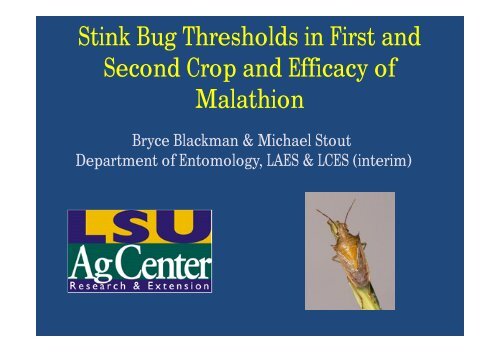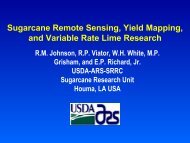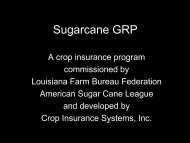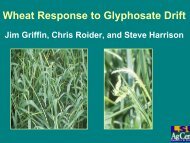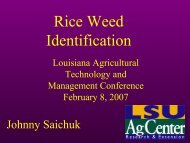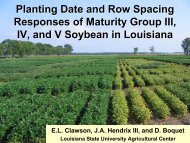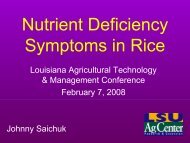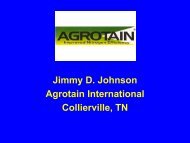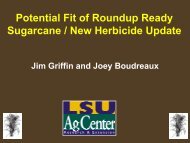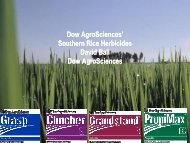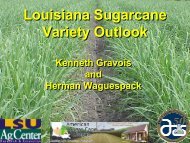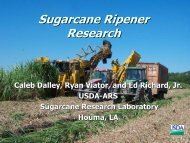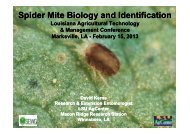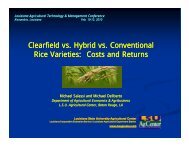Stink Bug Thresholds in First and Second Crop and Efficacy of ...
Stink Bug Thresholds in First and Second Crop and Efficacy of ...
Stink Bug Thresholds in First and Second Crop and Efficacy of ...
You also want an ePaper? Increase the reach of your titles
YUMPU automatically turns print PDFs into web optimized ePapers that Google loves.
Rice st<strong>in</strong>k bug managementprogramTransitional period• Loss/lack <strong>of</strong> efficacy <strong>of</strong> older<strong>in</strong>secticides• Introduction <strong>of</strong> new <strong>in</strong>secticides• Reevaluation <strong>of</strong> damage <strong>and</strong>thresholds• Other management tacticsYour <strong>in</strong>put is needed!
Adults <strong>and</strong>nymphsfeed ondevelop<strong>in</strong>grice gra<strong>in</strong>sAdult movement –weedy hosts tohead<strong>in</strong>g rice
Late <strong>in</strong>starAll <strong>in</strong>stars <strong>and</strong> adults suckout the contents <strong>of</strong>develop<strong>in</strong>g gra<strong>in</strong>s<strong>Bug</strong>s may carrypathogens on theirmouthparts – partlyresponsible for peckEarly <strong>in</strong>starJ. Saichuk
Rice <strong>St<strong>in</strong>k</strong> <strong>Bug</strong> DamageFeed<strong>in</strong>g on flowers (non-filled seed)Photograph by Boris CastroRemove contents <strong>of</strong> develop<strong>in</strong>gkernels (partially-filled seed)Pecky rice <strong>and</strong> broken kernels
Rice st<strong>in</strong>k bug – currentmanagement program• Adults can move <strong>in</strong>to fields rapidly afterhead<strong>in</strong>g• Adults are the primary damag<strong>in</strong>g stage• <strong>Thresholds</strong> are important – mere presence <strong>of</strong>st<strong>in</strong>k bugs <strong>in</strong> a field should not trigger spray<strong>in</strong>g• Scout with sweep net
Rice st<strong>in</strong>k bug – currentmanagement program• Beg<strong>in</strong> scout<strong>in</strong>g when rice is 50 to 75% head<strong>in</strong>g• 10 sweeps at 10 different areas• Avoid hot hours• <strong>First</strong> two weeks <strong>of</strong> head<strong>in</strong>g: 3 bugs per 10sweeps• After first two weeks: 10 bugs per 10 sweeps(gra<strong>in</strong>s become more resistant as they ripen)
Current Insecticide OptionsMalathionPyrethroidsOrganophosphatesCarbamateSev<strong>in</strong> ©Neonicot<strong>in</strong>oidsTenchu+ othersMethyl-Parathion
Rice st<strong>in</strong>k bug managementprogram• Loss/lack <strong>of</strong> efficacy <strong>of</strong> older<strong>in</strong>secticides• Introduction <strong>of</strong> new <strong>in</strong>secticides• Reevaluation <strong>of</strong> damage <strong>and</strong>thresholds• Other management tactics
Methyl parathion <strong>in</strong> riceEPA has received requests from the registrants tovoluntarily cancel all product registrations conta<strong>in</strong><strong>in</strong>gmethyl parathion, a restricted use organophosphate<strong>in</strong>secticide <strong>and</strong> acaricide used primarily on cotton,corn, <strong>and</strong> rice, as well as on other agricultural crops.These requests would term<strong>in</strong>ate the last methylparathion products registered for use <strong>in</strong> the U.S.,effective December 31, 2012. End-use products will notbe sold after August 31, 2013, <strong>and</strong> end-use productscannot legally be used after December 31, 2013. All enduse product labels will be amended to reflect the lastlegal use date.
Malathionefficacy –two trials, 2012TreatmentUntreated ControlKarate Z, 0.04 lbs ai/acreMalathion, 0.9 lbs ai/acreTenchu 20SG, 9.0 ozai/acreMean RSB <strong>in</strong> 10 Sweeps forthree sampl<strong>in</strong>g dates6.63 ±3.03AB3.96 ±2.82B6.75 ±4.10A5.83 ±4.81ABTreatment 1 DAT 3-4 DAT 6 DATUntreated 7.13 ±0.90 6.63 ±1.27 6.13 ±1.14ControlKarate Z, 0.04 3.25 ±0.90 4.00 ±1.30 4.63 ±0.80lbs ai/acreMalathion, 7.13 ±1.33 5.63 ±1.31 7.50 ±1.770.9 lbs ai/acreTenchu20SG,9.0 oz ai/acre5.00 ±2.04 5.88 ±1.67 6.63 ±1.54
Rice st<strong>in</strong>k bug managementprogram• Loss/efficacy <strong>of</strong> older <strong>in</strong>secticides• Introduction <strong>of</strong> new <strong>in</strong>secticides• Reevaluation <strong>of</strong> damage <strong>and</strong>thresholds• Other management tactics
Tenchu20 SG label• LX434 D<strong>in</strong>otefuran 20SG• Rate: 7.5 to 10.5 oz. product per Acre (0.094-0.131 lbs ai per Acre)• Labeled only for rice st<strong>in</strong>k bug <strong>in</strong> rice• Maximum <strong>of</strong> two applications per year• 7 d phi• Crawfish restrictions• Wait<strong>in</strong>g on state label
Fastaclabel• Active <strong>in</strong>gredient: alpha-cypermethr<strong>in</strong>(pyrethroid)• Rate: 2.6 to 3.8 fl oz/acre (0.02-0.025 lbai/acre)• Use like other pyrethroids• Do not apply > 11.4 fl oz/acre/year• “Do not use treated rice fields for theaquaculture …”• Rice water weevil, aphids, armyworms, st<strong>in</strong>kbugs
2011 Small Plot Insecticide <strong>Efficacy</strong>35301DAT2DAT5DATRSB Adults / 10 Sweeps2520151050Control Endigo 2.06 TenchuCentric Endigo 2CX KarateTreatments
2011 Small Plot Insecticide <strong>Efficacy</strong>25Nymphs / 10 Sweeps20151051DAT2DAT5DAT0Control Endigo 2.06 TenchuTreatmentsCentric Endigo 2CX Karate
Percent reduction <strong>in</strong> RSB numbers - 24hr before treatmentvs. 48hr after treatment.
Percent pecky rice by treatment (Pyrethroid- yellow,Tenchu 20 SG- Blue) at each location.
Rice st<strong>in</strong>k bug managementprogram• Loss/efficacy <strong>of</strong> older <strong>in</strong>secticides• Introduction <strong>of</strong> new <strong>in</strong>secticides• Reevaluation <strong>of</strong> damage <strong>and</strong>thresholds• Other management tacticsYour <strong>in</strong>put is needed!
Why re-evaluate applicationthresholds?• Orig<strong>in</strong>s <strong>of</strong> current thresholds unknown• Recent results from TX suggest thresholds maybe too low – spray<strong>in</strong>g too much?• New <strong>in</strong>secticides, varieties‣<strong>First</strong> step: re-evaluate relationship betweenst<strong>in</strong>k bug density <strong>and</strong> damage (peck, blanks)
Rice <strong>St<strong>in</strong>k</strong> <strong>Bug</strong> Cage Studies
Beg<strong>in</strong>n<strong>in</strong>g:Plant 5 Plots <strong>of</strong>CocodrieCage StudyInstall Cages at<strong>First</strong> Sign <strong>of</strong>EmergenceInfest with0,2,5,10, or 20RSB Adults
Sweep net sampl<strong>in</strong>g efficiency# <strong>of</strong> bugs recovered from plots4.543.532.521.510.50y = 0.1634xR² = 0.58520 5 10 15 20 25# <strong>of</strong> bugs “seeded” <strong>in</strong>to plots
RSB RSB Cage Cage Study Study–Recapture rate is 16%–Early LA threshold is 0.3 RSB per sweep(= 3 RSB per 10 sweeps)–So, threshold <strong>of</strong> 0.3/sweep isequivalent to 1.88 bugs actuallypresent <strong>in</strong> the sweep radius
RSB RSB Cage Cage Study Study–Cages are 6.67 sq. ft–Recommended sweep coversapproximately 9.5 sq. ft.–Cage area is 70% <strong>of</strong> 1 sweep
RSB RSB Cage Cage Study Study–3 RSB per 10 sweeps equates to 1.313RSB per cage– 2010-Cage Study 4 reps w/ 0, 1, 2, 5,or 10 bugs per cage– 2011 & 2012-4 reps each year w/ 0, 2,5, 10, 20 bugs per cage
Beg<strong>in</strong>n<strong>in</strong>g:Plant 5 Plots <strong>of</strong>CocodrieCage StudyInstall Cages at<strong>First</strong> Sign <strong>of</strong>EmergenceInfest with0,2,5,10, or 20RSB AdultsCountPaniclesHarvestedHarvestEntire CageSpray TwiceWeekly UntilGra<strong>in</strong> Harden<strong>in</strong>gRemoveCages After14 DaysH<strong>and</strong> Thresh<strong>and</strong> WeighRough RiceSeparateBlank Hulls<strong>and</strong> WeighShell 100 gm<strong>and</strong> Calculate% Pecky Ricedue to RSBResult:Correlate %Pecky Ricewith RSB per10 Sweeps
4.52010 <strong>and</strong> 20114% Peck3.53y = 0.0483x + 3.0472R² = 0.6912.520 5 10 15 20 25RSB Infestation Density% peck <strong>in</strong> unpolished rice, broken <strong>and</strong> whole gra<strong>in</strong>s
Threshold development– Statistical analysis– Relate damage (peck, blanks) to economiclosses (yield loss, penalties for peck)– Adjust for rice prices, <strong>in</strong>secticide costs, etc.to obta<strong>in</strong> economic threshold– Verification– Expect prelim<strong>in</strong>ary answers by June(tra<strong>in</strong><strong>in</strong>g session?)
Rice st<strong>in</strong>k bug managementprogram• Loss/efficacy <strong>of</strong> older <strong>in</strong>secticides• Introduction <strong>of</strong> new <strong>in</strong>secticides• Reevaluation <strong>of</strong> damage <strong>and</strong>thresholds• Other management tactics
Nymphsdevelop onripen<strong>in</strong>ggra<strong>in</strong>sAdult movement –weedy hosts tohead<strong>in</strong>g rice
Unanswered questions – rice st<strong>in</strong>kbug biology• What causes adult st<strong>in</strong>k bugs to move <strong>in</strong> <strong>and</strong>out <strong>of</strong> fields (nymphs cannot fly)?• How much damage do nymphs cause?--do immature st<strong>in</strong>k bugs develop rapidlyenough to cause economic <strong>in</strong>jury todevelop<strong>in</strong>g rice gra<strong>in</strong>s?• How much impact do natural enemies have?
Questions or feedback?Michael Stout(225) 892-2972mstout@agcenter.lsu.edu


